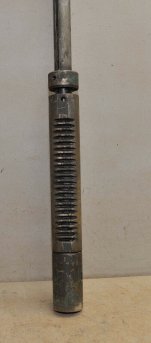Hello,
My first post here, despite I’ve been reading for quite some time. I live in Europe so please forgive me my mistakes in English.
I recently managed to save a camelback drill (brand “Rico”) from being scrapped as the owner passed away and the family sold the house. Despite being outside it was heavily covered in grease and oil and quickly functioning after cleaning. However I noticed it had so much runout it was impossible to use it. I measured 0,8 mm TIR runout. Part of it is because of a bend in the spindle, which I will try to repair with my fathers hydraulic press. However I also notice quite a bit of play (about 0,3 mm TIR). The quil is just a cast iron tube with the spindle running inside of it, no bearings or bushings. I could bore it out and press in some bushings, but the spindle itself also has some wear which is harder to repair. I can’t really turn down the entire OD as the spindle is only slightly larger than the keyed upper portion of the spindle that slides inside the crown gear. Also the nut is on there with an M28 thread (shaft is also 28 mm, upper part 25 mm). I could weld up the worn area but fear warping the shaft.
I also considered machining a two halve sleeve to increase the spindle size to 30 mm and install some cone bearings. However this is tricky as there is not much material left for the quill in that case.
Any advice? Tossing the drill also is an option but as it was very cheap I assume some work to get it functional might be worth it.
My first post here, despite I’ve been reading for quite some time. I live in Europe so please forgive me my mistakes in English.
I recently managed to save a camelback drill (brand “Rico”) from being scrapped as the owner passed away and the family sold the house. Despite being outside it was heavily covered in grease and oil and quickly functioning after cleaning. However I noticed it had so much runout it was impossible to use it. I measured 0,8 mm TIR runout. Part of it is because of a bend in the spindle, which I will try to repair with my fathers hydraulic press. However I also notice quite a bit of play (about 0,3 mm TIR). The quil is just a cast iron tube with the spindle running inside of it, no bearings or bushings. I could bore it out and press in some bushings, but the spindle itself also has some wear which is harder to repair. I can’t really turn down the entire OD as the spindle is only slightly larger than the keyed upper portion of the spindle that slides inside the crown gear. Also the nut is on there with an M28 thread (shaft is also 28 mm, upper part 25 mm). I could weld up the worn area but fear warping the shaft.
I also considered machining a two halve sleeve to increase the spindle size to 30 mm and install some cone bearings. However this is tricky as there is not much material left for the quill in that case.
Any advice? Tossing the drill also is an option but as it was very cheap I assume some work to get it functional might be worth it.


